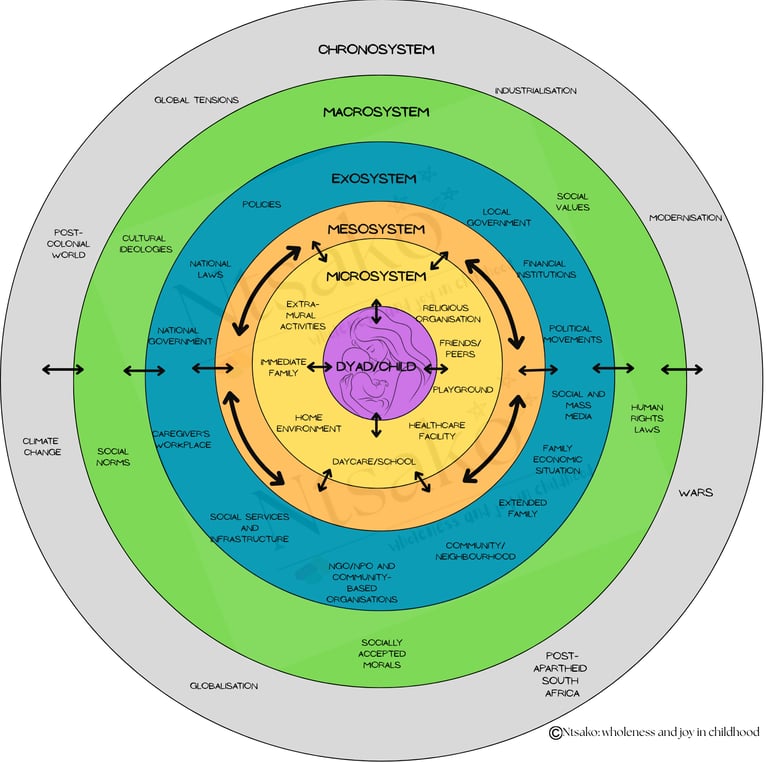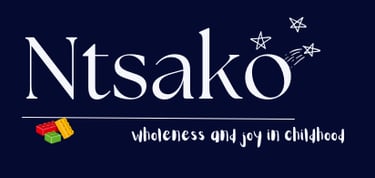
A Person In Context - Some Practical Examples Bronfenbrenner
Part 1.4 - A way to visualise how we use Bronfenbrenner's theory to better understand development and intervention efforts
ISSUE 1
VJ Tlakula
4/30/20256 min read


Contextually and Practically Applying Bronfenbrenner's Model
Below I provide a few contextual examples of how different levels (systems) of the environment can interact with and impact on each other. First, I will come back to previous discussions in Issue 1 to show how everything links. Two of the examples are common contextual occurrences to show how we understand what's going on in the child's life. Another two demonstrate the potential of intervention projects. As I discuss, I place in parentheses (dyad, micro-, meso- exo-, macro-, chrono-) to illustrate which system the action/effect is happening in related to the child specifically. Revise the different systems here.
These examples can be a bit extreme in nature to illustrate the point, but while they do not happen in this exact way every single time, they are very much likely to and do happen this way many times. They are also quite simplistic examples in the sense that there are always multiple factors at play. We do not only understand development through this model. This is just one of many models and theories that work together. As I stated in A Person in Context, even though we use this model, it is not deterministic in its application. Meaning that these outcomes don't happen 10 out of 10 times. Even though this model is mainly applied to children and development, it can also be applied to individuals of any age.
Historical Change: Concept of the child and Child Rights
Allow me to take us back to Part 2 and Part 3 of this Issue. What led to the change of how children were conceptualised started in individual homes of philosophers, writers, and artists (micro-). They began to think of children differently and so began portraying and speaking about them differently (exo-). This attitude caught on and began to change more people's thinking about children (macro-). Thus, they began fighting for children's rights. Laws were put in place to protect the rights (exo-; macro-). Therefore, workplaces stopped using child labour and more children were placed in schools (micro-). Additionally, as the industrial revolution began to open up more varied job opportunities, families had to send their children to schools. Families could have better opportunity for social progression and the world changed (chrono-).
Contextual Examples
Abusive parenting on child
Consider the case of a caregiver who physically or verbally abuses their young child. Abusive parenting affects the attachment relationship between the parent and the child (dyad). The child does not experience enough love and safety at home (micro-). Also affected are the child’s school performance and social interactions, as the child may have too much of a stress response and are not taught to regulate themselves well, so they struggle to behave and concentrate (micro-; meso-). This can lead to a child growing up as a delinquent (naughty and troublemaking), which, if left unchecked, may lead to a life of crime and substance abuse. Their criminal activity may get them into trouble with the law which does not agree with their actions, based on social norms and beliefs (exo-; macro-).
In a social context with all-time high economic struggles and unemployment (exo-), accessing opportunities may become very difficult for this person as they never really learned how to navigate the world in a healthy way or never succeeded in school (dyad; micro-; meso-). They become isolated and possibly a burden on social systems (grants, diseases, rehab). This child may end up having extremist values (macro-) and might end up having their own child who they pass these values on to (dyad. micro-), repeating what they learnt (abuse and even worse) and possibly leading their child to become like this and even worse growing up. If this happens in enough values, in the future we could have societies filled with crime, high disease, and delinquency (chrono-).
Stressed out parent
Now consider the parent of the abused child. They are not as black-and-white and evil a character as we might immediately want to make them out to be. Say, for example, that this parent works a minimum-wage job in a toxic, overworking environment where they struggle to pay their bills and support their family (micro-; exo-). This job also takes so much time that they struggle to prioritise bonding time with family, are always exhausted and develop a difficult relationship with their family (micro-; meso-; exo-).
They might get easily frustrated with their child when they possibly waste food, or misbehave, or break or lose something because resources are so low. They might take out this frustration on the child violently either because they can’t help it and can’t think straight, or to try to teach the child a lesson (dyad). They do not have the time, capacity, or know the tools to slowly teach the child (dyad; micro-; exo-). Their poor work situation might mean that they cannot take their child to a good school to provide opportunities for upward social mobility for their child, like getting into university and studying something which may give their child a good career (exo-).
They may live in a dangerous community with lower property value and service delivery/access to resources, where they must always be on high alert to survive (meso-; exo-). There may be inflation and a nation in turmoil and corruption where policies and laws serve the interests of those who have the power and money to influence them (exo-; macro-; chrono-). At this level, the family is then affected by social development systems, NGOs, and human rights (exo-). This person is in a lower social class (macro-) due to the enduring effects of Apartheid on their family/racial group (chrono-; macro-), and the cycle might be repeated again with their own child because the opportunities they are given (chrono-).
Applying the model to interventions
Parenting Intervention
Now, let us consider this same caregiver-child dyad and if we apply an intervention. Parenting interventions are mostly aimed at improving the life of the caregiver so that they can better care for the young child (dyad). This includes health and wellbeing, because when a caregiver is no longer concerned with these things, they are able to see how possibly, stress and financial concerns (exo-)were affecting their relationship with their children (micro-). These kinds of interventions could be getting caregivers employed (exo-), getting support for common caregiver needs, or teaching caregivers more about their children (micro-; meso-; exo-). These interventions strive to improve the relationship between caregiver and child, because, as we will see in nearly all later Issues, this relationship is crucial to so much of the child’s development and its healthy success.
Community-level Intervention
It's good to improve individual lives of caregivers and children, but an intervention is most effective and has a more lasting impact when the community surrounding the caregiver and child is included in it. These kinds of interventions occur at the meso- and exo- levels. They are useful in creating an evidence base of things that work to make a community safer or help with child development (meso-). This kind of an evidence base can help to motivate for policies which serve the interest of the community more (exo-; macro-). They can also help with bringing more unity in the community and helping them to mobilise against corruption, crime or advocate for their rights in a healthy way (meso-; exo-; macro-). It can also make the government more sensitive to community issues, which in the long run can create a macro- level change. The different social spaces (microsystems) that different community members will go into can be influenced as well, as well as the children, ensuring better outcomes for them.
Concluding thoughts
These examples take a mostly social approach. However, in following Issues I discuss a bit more the biological elements that cause children to develop and respond to their environments in certain ways.
In this discussion, I am not trying to state that everyone is a consequence or victim of their circumstance or even that we only ever blame the society for the failings of the individual. What I am saying is that societies are made up of individuals and children particularly are at the mercy of their society. We can never truly ignore the role of the society in the good and bad outcomes of development
This is why I always discuss the person in context. To show that the context and environment is extremely crucial when trying to understand child development. It helps us to better understand the young child, how vulnerable they are, the person they could become, and the trends they could perpetuate. We also discuss this to show that positive change can happen, and the environment can be leveraged to bring about that change. The optimist in me believes that if we can grasp this concept and use it well, it could change society as a whole in the long run.
So, the next time you see a child and they might be behaving in a certain way, before jumping to any kind of conclusion, try to remember that they are ultimately a person in context and try to consider what that context might be like and what it may be doing to them. Also consider how it could be changed and your role in that. Perhaps that way we may all be just a bit kinder in our thoughts towards them.


Share your Comments Below!
Please feel free to reach out with any comments, questions, and child-related stories
Celebrating childhood and development
© Ntsako Wholeness and Joy in Childhood 2025. All rights reserved.
Copyright Vutlhari Joy Tlakula 2025. All Rights Reserved.


